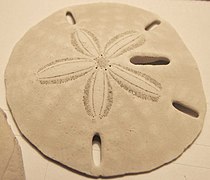“Horizon”. An
expansive, all-encompassing, promising word – and the title of the book I’m
reading. The author, Barry Lopez, was recommended to me years ago by the man
next to me on a flight from somewhere. I am pleased with my choice. In an autobiographical
style, Lopez, a worldwide traveler and nature writer, relates how his interests
developed from childhood into adulthood and then proceeds to take the reader to
visit memorable places he’s traveled, searching for deeper truths to be found
in those places.
I instantly relate to his habit of returning home with mementos from
afar. In an earlier life I may have belonged to a hunter-gatherer tribe. When
I’m out and about, I can’t resist depositing a unique rock, a seed pod or a
feather into my pocket. Offerings from the Earth.
Here in my study a fossil poses on a shelf. Elongated and pointy,
the gray-brown rock bears the reddish imprint of an ancient sea dollar. The
design stood out in a vast windswept plain awash with marine fossils. Here it
was not difficult to imagine that this Patagonian plain was once ocean floor
pushed upwards over the millennium to form the Andean cordillera, the vertical
column of South America. What an overwhelming thought to know that I was
standing on geological history.
If I rustle through the papers in a drawer of my night table, I’ll
come across the silky softness of an owl down feather, given to me years ago by
the writing coach of a workshop at Los Parronales farm. I was the first to notice
the owls there and whenever we return, people ask, “Have you seen the owls yet?”
and we cross a field to scan the “owl trees.” The feather reminds me of the
joyful companionship of those workshop days. Over the years, urban sprawl
creeps closer to the farm. Once those
trees are felled to make way for factories, where will the owls find refuge?
A basket of rocks sits on my round oak table off the kitchen: a shiny
black rough chunk of volcanic lava from Easter Island; a wafer-thin oval
deposited on a beach by the retreating Marinelli Glacier; a pale grey pumice ball
expelled from the Calbuco volcano and propelled by a river into a Patagonian
lake; a sliver of shale plucked from the edge of Glen Alpine Creek in the
California Sierras. As I hold each in my hand, I am reconnected with the place
that prompted me to bring home a piece of that landscape.
I cannot walk a beach without “combing” it, alert to an offering
from the sea, the origin of all. Shells in a variety of shapes and sizes: compact
bivalves and smooth gastropods left on a sandy strand in Costa Rica or a
pristine Galapagos beach, or a sand dollar found on a Monterey Bay shore. I
think of shells as feminine. Plain or intricately designed, white exteriors
with blushes of pale pink within. I wonder what creature once lived within. Did
you tumble in with a crashing, booming wave? How far did you travel? Are you a
descendent of the First Mollusk?

Being a transplant to this country, I’ve made an effort to learn to
identify the native vegetation. My book of “Flora Silvestre de Chile, Zona
Austral” (Native Chilean Vegetation, southern region) bulges with dried leaf
specimens, each inserted into the species’ corresponding page. Not having grown
up with these species, I need memory aides to take me back to treks through the
lush temperate rainforests of Patagonia, inhabited by wild fuchsia, the ancient
alerce and the Nothofagus families of trees, giant ferns, nalca (giant rhubarb)
leaves (umbrellas for hidden frogs), the iconic araucaria (monkey puzzle tree).
Like the rocks and the seashells, these trees are remnants of ancient times. My
eyes follow the trunk of an alerce, up, up to its towering peak and I try to
imagine what this landscape was like millennia ago when the tree first took
root.
My mementos had their origins in the Earth. They tell an awe-inspiring
story too huge to comprehend. I have them here in my city home so that I will
never forget.

No comments:
Post a Comment